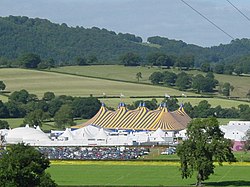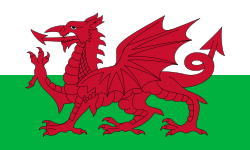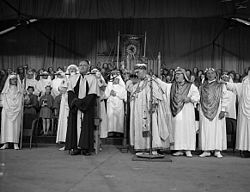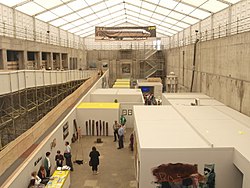National Eisteddfod of Wales
 From Wikipedia - Reading time: 17 min
From Wikipedia - Reading time: 17 min
| National Eisteddfod of Wales Eisteddfod Genedlaethol Cymru (Welsh) | |
|---|---|
 Logo | |
 | |
| Status | Active |
| Genre | Cultural, music, poetry |
| Frequency | Annual (1st week of August) |
| Location(s) | Multiple |
| Country | United Kingdom (Wales)† |
| Established | 1861 |
| Participants | 6,000 |
| Attendance | 100,000 – 186,000 |
| Leader | Betsan Moses (Chief Executive) |
| Website | eisteddfod eisteddfod |
| † The festival has occasionally been held in England in the past. | |
The National Eisteddfod of Wales (Welsh: Eisteddfod Genedlaethol Cymru ⓘ) is the largest of several eisteddfodau that are held annually, mostly in Wales. Its eight days of competitions and performances are considered the largest music and poetry festival in Europe.[1] Competitors typically number 6,000 or more, and overall attendance generally exceeds 100,000 visitors,[2] the highest recently being 186,000 attending the 2024 festival in Pontypridd.[3] The 2018 Eisteddfod was held in Cardiff Bay with a fence-free 'Maes'. In 2020, the event was held virtually under the name AmGen; events were held over a one-week period.
History
[edit]
The National Museum of Wales says that "the history of the Eisteddfod may [be] traced back to a bardic competition held by the Lord Rhys in Cardigan Castle in 1176",[4] and local Eisteddfodau were certainly held for many years prior to the first national Eisteddfod. Even before they became a regular annual event, Eisteddfodau were held on a national scale in Wales, such as the Gwyneddigion Eisteddfod of 1789, the Provincial Eisteddfodau from 1819 to 1834,[5] the Abergavenny Eisteddfodau of 1835 to 1851,[6][7][8] and The Great Llangollen Eisteddfod of 1858.[9] However the National Eisteddfod of Wales as an organisation traces its history back to the first event held in 1861, in Aberdare.[10][11]
One of the most dramatic events in Eisteddfod history was the award of the 1917 chair to the poet Ellis Humphrey Evans, bardic name Hedd Wyn, for the poem Yr Arwr (The Hero). The winner was announced, and the crowd waited for the winner to stand up to accept the traditional congratulations before the chairing ceremony, but no winner appeared. It was then announced that Hedd Wyn had been killed the previous month on the battlefield at Passchendaele in Belgium. These events were portrayed in the Academy Award nominated film Hedd Wyn.[12] In 1940, during the Second World War, the Eisteddfod was not held, for fear that it would be a bombing target. Instead, the BBC broadcast an Eisteddfod radio programme, and the Chair, Crown and a Literature Medal (as opposed to the usual Prose Medal) were awarded.[13]
From 1950 onward, a newly created rule required all competitions to be held in Welsh. However, settings of the mass in Latin are allowed and this has been controversially used to allow concerts featuring international soloists.[14]
In recent years efforts have been made to attract more non-Welsh speakers to the event, with the official website stating "everyone is welcome at the Eisteddfod, whatever language they speak". The Eisteddfod offers bilingual signage and simultaneous translation of many events though wireless headphones. There is also a Welsh learners area called Maes D. These efforts have helped increase takings, and the 2006 Eisteddfod reported a profit of over £100,000, despite costing £2.8m to stage. The Eisteddfod attracts some 160,000 people annually. The National Eisteddfod in Cardiff (2008) drew record crowds, with over 160,000 visitors attending.[citation needed]
It was proposed that the 2018 National Eisteddfod in Cardiff would use permanent buildings to host events, rather than the traditional Maes site and tents. This was due partially to a lack of suitable land that could be repaired affordably after the festival. It was billed as an "Eisteddfod with no fence" in the media and was held at Cardiff Bay.[15][16][17] The 2019 Eisteddfod in Llanrwst returned to the traditional Maes.
The 2020 Eisteddfod was postponed for 12 months because of the international COVID-19 pandemic. This was the first year no Eisteddfod had taken place since 1914, when the event was cancelled at short notice because of the outbreak of the Great War.[18]
| Part of a series on the |
| Culture of Wales |
|---|
 |
| People |
| Art |
Attendance
[edit](incomplete)
| Year | Total attendance | Profit/loss |
|---|---|---|
| 2002 | 144,220 | – |
| 2003 | 176,402 | +£3,000[19] |
| 2004 | 147,785 | –£291,000[19] |
| 2005 | 157,820 | +£220,000[20] |
| 2006 | 155,437 | +£100,000 |
| 2007 | 154,944[21] | +£4,324[22] |
| 2008 | 156,697 | +£38,000[23] |
| 2009 | 164,689 | +£145,000[24] |
| 2010 | 136,933[25] | –£47,000[24] |
| 2011 | 148,892[26] | -£90,000[24] |
| 2012 | 138,767[27] | +£50,000 |
| 2013 | 153,704[26] | +£76,000 |
| 2014 | 143,502 | +£90,000 |
| 2015 | 150,776 | +£54,721[28] |
| 2016 | 140,229 | +£6,000[29] |
| 2017 | 147,498 | +£93,200[30] |
| 2018 | ~500,000 | –£290,000[31] |
| 2019 | 150,000 | –£158,982[32] |
Overview
[edit]


The National Eisteddfod is traditionally held in the first week of August, and the competitions are all held in the Welsh language. However, settings of the mass in Latin are allowed and this has been controversially used to allow concerts featuring international soloists.[33]
| Eisteddfod Act 1959 | |
|---|---|
| Act of Parliament | |
 | |
| Long title | An Act to make further provision for contributions by local authorities in Wales (including Monmouthshire) towards the expenses of the Royal National Eisteddfod. |
| Citation | 7 & 8 Eliz. 2. c. 32 |
| Dates | |
| Royal assent | 30 April 1959 |
| Other legislation | |
| Repealed by | Statute Law (Repeals) Act 2004 |
Status: Repealed | |
The venue is officially proclaimed a year in advance, at which time the themes and texts for the competitions are published. The organisation for the location will have begun a year or more earlier, and locations are generally known two or three years ahead. The Eisteddfod Act 1959 (7 & 8 Eliz. 2. c. 32) allowed local authorities to give financial support to the event. Traditionally, the Eisteddfod venue alternates between north and south Wales; the decision to hold both the 2014 and 2015 Eisteddfodau in South Wales was thus seen as controversial,[34] but the decision was later reversed and Montgomeryshire named as host county for 2015.[35] Occasionally the Eisteddfod has been held in England, although the last occasion was in 1929.[10]
Hundreds of tents, pavilions and booths are erected in an open space to create the Maes (field). The space required for this means that it is rare for the Eisteddfod to be in a city or town: instead it is held somewhere with more space. Car parking for day visitors alone requires several large fields, and many people camp on the site for the whole week.
The festival has a quasi-druidic flavour, with the main literary prizes for poetry and prose being awarded in colourful and dramatic ceremonies under the auspices of the Gorsedd of Bards of the Island of Britain, complete with prominent figures in Welsh cultural life dressed in flowing druidic costumes, flower dances, trumpet fanfares and a symbolic Horn of Plenty. However, the Gorsedd is not an ancient institution or a pagan ceremony but rather a romantic creation by Iolo Morganwg in the 1790s, which first became a formal part of the Eisteddfod ceremonial in 1819.[4] Nevertheless, it is taken very seriously, and an award of a crown or a chair for poetry is a great honour. The Chairing and Crowning ceremonies are the highlights of the week, and are presided over by the Archdruid. Other important awards include the Prose Medal (first introduced in 1937) and Welsh Learner of the Year award (first introduced in 1983).
There are three ranks of membership in the Gorsedd. Until 2012 they were, in ascending order of honour:[36]
- Ovates, who wear green robes (Green signifying a verdant spring)
- Bards, who wear blue robes, and (Blue signifying the season)
- Druids, who wear white robes. (White signifying old age and sanctity)[37][38]
If no stone circle is there already, one is created out of Gorsedd stones, usually taken from the local area. These stone circles are icons all across Wales and signify the Eisteddfod having visited a community. As a cost-saving measure, the 2005 Eisteddfod was the first to use a temporary "fibre-glass stone" circle for the druidic ceremonies instead of a permanent stone circle. This also has the benefit of bringing the Gorsedd ceremonies onto the maes: previously they were often held many miles away, hidden from most of the public.
As well as the main pavilion with the main stage, there are other venues through the week. Some are fixtures every year, hosting gigs (Maes B/Llwyfan y Maes/Caffi Maes B). Other fixtures of the maes are the Pabell Lên (literature pavilion), the Neuadd Ddawns (dance hall), the Pabell Wyddoniaeth a Thechnoleg (science and technology pavilion), Maes D (learners' pavilion), at least one theatre, Y Cwt Drama (the drama hut), Tŷ Gwerin (folk house), Y Lle Celf ("the Art Place") and hundreds of stondinau (stands and booths) where groups, societies, councils, charities and shops exhibit and sell. Since 2004, alcohol has been sold on the maes; previously there was a no-alcohol policy.
Poetry awards
[edit]The Eisteddfod's most well-known awards are those for poetry.
Chairing of the Bard
[edit]The chair is awarded for an awdl, a long poem in strict metre. A new bardic chair is specially designed and made for each eisteddfod.
Crowning of the Bard
[edit]The crown is awarded for a pryddest, a poem in free verse. A new bardic crown is specially designed and made for each eisteddfod. The competition for the pryddest was first introduced to the National Eisteddfod in 1867. A medal rather than a crown was awarded that year.[39]
Pryddest
[edit]Pryddest is a literary term used in Welsh to describe a genre of poetry in free metre. It refers to a single poem, as opposed to a collection of poems, in the context of the competition for the Eisteddfod Crown. Although the earliest example of the word can be found in the work of the Poets of the Princes (meaning poem or song), and according to the University of Wales Dictionary the word is the source of the verb prydaf, meaning "to compose poetry",[40] the bardic form is mainly connected with the Eisteddfod. It corresponds to the awdl in strict metre.
The pryddest can be composed in one or more free metres, and there are no important rules about its length, nor about its form. These relaxed rules mean that bards that compose pryddestau enjoy much more freedom in comparison with the strict verse competitions for the chair.
Welsh-language album of the year
[edit]In 2014, the Eisteddfod began to award a Welsh-language Album of the Year (Albwm Cymraeg Y Flwyddyn) during its Maes B event.[41]
| Year | Winner |
|---|---|
| 2014 | The Gentle Good – Y Bardd Anfarwol[41] |
| 2015 | Gwenno – Y Dydd Olaf[42] |
| 2016 | Sŵnami – Sŵnami[43] |
| 2017 | Bendith – Bendith[44] |
| 2018 | Mellt – Mae’n Hawdd Pan ti’n Ifanc[45] |
| 2020 | Ani Glass ‒ Mirores[46] |
| 2021 | Mared – Y Drefn[47] |
| 2022 | Sywel Nyw – Deuddeg[48] |
| 2023 | Pedair - mae ‘na olau |
| 2024 | Cowbois Rhos Botwnnog - Mynd â'r tŷ am dro[49] |
National Eisteddfod venues
[edit](Venues in England are in italics)[50]
- 1861 – Aberdare
- 1862 – Caernarfon
- 1863 – Swansea
- 1864 – Llandudno
- 1865 – Aberystwyth
- 1866 – Chester
- 1867 – Carmarthen
- 1868 – Ruthin
- 1869 – Holywell (unofficial)
- 1870 – Rhyl (unofficial)
- 1871 – Tywyn (unofficial)
- 1872 – Tremadog (unofficial)
- 1873 – Mold (unofficial)
- 1874 – Bangor (unofficial)
- 1875 – Pwllheli (unofficial)
- 1876 – Wrexham (unofficial)
- 1877 – Caernarfon (unofficial)
- 1878 – Birkenhead (unofficial)
- 1879 – Conwy (unofficial)
- 1880 – Caernarfon
- 1881 – Merthyr Tydfil
- 1882 – Denbigh
- 1883 – Cardiff
- 1884 – Liverpool
- 1885 – Aberdare
- 1886 – Caernarfon
- 1887 – London (Royal Albert Hall)
- 1888 – Wrexham
- 1889 – Brecon
- 1890 – Bangor
- 1891 – Swansea
- 1892 – Rhyl
- 1893 – Pontypridd
- 1894 – Caernarfon
- 1895 – Llanelli
- 1896 – Llandudno
- 1897 – Newport
- 1898 – Blaenau Ffestiniog
- 1899 – Cardiff
- 1900 – Liverpool
- 1901 – Merthyr Tydfil
- 1902 – Bangor
- 1903 – Llanelli
- 1904 – Rhyl
- 1905 – Mountain Ash
- 1906 – Caernarfon
- 1907 – Swansea
- 1908 – Llangollen
- 1909 – London (Royal Albert Hall)
- 1910 – Colwyn Bay
- 1911 – Carmarthen
- 1912 – Wrexham
- 1913 – Abergavenny
- 1914 – Not held
- 1915 – Bangor
- 1916 – Aberystwyth
- 1917 – Birkenhead
- 1918 – Neath
- 1919 – Corwen
- 1920 – Barry
- 1921 – Caernarfon
- 1922 – Ammanford
- 1923 – Mold
- 1924 – Pontypool
- 1925 – Pwllheli
- 1926 – Swansea
- 1927 – Holyhead
- 1928 – Treorchy
- 1929 – Liverpool
- 1930 – Llanelli
- 1931 – Bangor
- 1932 – Aberavon
- 1933 – Wrexham
- 1934 – Neath
- 1935 – Caernarfon
- 1936 – Fishguard
- 1937 – Machynlleth
- 1938 – Cardiff
- 1939 – Denbigh
- 1940 – Mountain Ash (Radio Eisteddfod)
- 1941 – Old Colwyn
- 1942 – Cardigan
- 1943 – Bangor
- 1944 – Llandybie
- 1945 – Rhosllannerchrugog
- 1946 – Mountain Ash
- 1947 – Colwyn Bay
- 1948 – Bridgend
- 1949 – Dolgellau
- 1950 – Caerphilly
- 1951 – Llanrwst
- 1952 – Aberystwyth
- 1953 – Rhyl
- 1954 – Ystradgynlais
- 1955 – Pwllheli
- 1956 – Aberdare
- 1957 – Llangefni
- 1958 – Ebbw Vale
- 1959 – Caernarfon
- 1960 – Cardiff
- 1961 – Rhosllannerchrugog
- 1962 – Llanelli
- 1963 – Llandudno
- 1964 – Swansea
- 1965 – Newtown
- 1966 – Aberavon
- 1967 – Bala
- 1968 – Barry
- 1969 – Flint
- 1970 – Ammanford
- 1971 – Bangor
- 1972 – Haverfordwest
- 1973 – Ruthin
- 1974 – Carmarthen
- 1975 – Criccieth
- 1976 – Cardigan
- 1977 – Wrexham
- 1978 – Cardiff
- 1979 – Caernarfon
- 1980 – Gowerton – Lliw Valley
- 1981 – Machynlleth
- 1982 – Swansea
- 1983 – Llangefni
- 1984 – Lampeter
- 1985 – Rhyl
- 1986 – Fishguard
- 1987 – Porthmadog
- 1988 – Newport
- 1989 – Llanrwst
- 1990 – Rhymney Valley
- 1991 – Mold
- 1992 – Aberystwyth
- 1993 – Llanelwedd
- 1994 – Neath
- 1995 – Abergele
- 1996 – Llandeilo (Ffairfach)
- 1997 – Bala
- 1998 – Bridgend (Pencoed)
- 1999 – Anglesey (Llanbedrgoch)
- 2000 – Llanelli
- 2001 – Denbigh
- 2002 – St David's
- 2003 – Meifod, near Welshpool
- 2004 – Newport
- 2005 – Faenol Estate, near Bangor
- 2006 – Swansea (Felindre)
- 2007 – Mold
- 2008 – Cardiff
- 2009 – Bala
- 2010 – Ebbw Vale[34][51][52]
- 2011 – Wrexham[34]
- 2012 – Llandow, Vale of Glamorgan[34]
- 2013 – Denbigh[34]
- 2014 – Llanelli
- 2015 – Meifod, near Welshpool
- 2016 – Abergavenny
- 2017 – Bodedern, Anglesey
- 2018 – Cardiff (Cardiff Bay)
- 2019 – Llanrwst
- 2020 – Not held[53]
- 2021 – Not held[54]
- 2022 – Tregaron
- 2023 – Boduan
- 2024 – Pontypridd
- 2025 – Isycoed, Wrexham[55]
- 2026 – Llantwd, Pembrokeshire
The Eisteddfod has visited all the traditional counties of Wales. It has visited six of the seven current cities in Wales: Bangor, Cardiff, Newport, St David's, Swansea and Wrexham. It visited Wrexham when it was classified as a town; Wrexham attained city status in 2022. It has never visited St Asaph, which attained city status in 2012.
See also
[edit]References
[edit]- ^ Williams, Sian. "Druids, bards and rituals: What is an Eisteddfod?". BBC. Retrieved 2 March 2016.
- ^ Gregory, Rhys (2022-06-06). "Record numbers at 2022 Urdd National Eisteddfod". Retrieved 2024-08-27.
- ^ "Senedd Hails 'Best Ever' Eisteddfod". Retrieved 2024-09-21.
- ^ a b "History of the Welsh Eisteddfodau". National Museum Wales. Retrieved 2017-10-15.
- ^ "The Provincial Eisteddfodau 1819–1834". National Museum Wales. Retrieved 2017-10-15.
- ^ "The Abergavenny Eisteddfod | National Museum Wales". Museum.wales. Retrieved 2017-10-15.
- ^ "Welsh National Eisteddfodau". Genuki. 23 February 2013. Retrieved 8 April 2013.
- ^ "History of the Welsh Eisteddfodau". National Museum Wales. Archived from the original on 14 June 2013. Retrieved 8 April 2013.
- ^ "The Great Llangollen Eisteddfod, 1858 | National Museum Wales". Museum.wales. Retrieved 2017-10-15.
- ^ a b "Past locations". National Eisteddfod of Wales. Archived from the original on July 29, 2014. Retrieved 8 April 2013.
- ^ "The Eisteddfod: 1861–1885". National Eisteddfod of Wales. Archived from the original on July 29, 2014. Retrieved 8 April 2013.
- ^ "Media Education Wales: Hedd Wyn (English)". Media Ed website. British Film Institute. 2001. Archived from the original on 10 November 2014. Retrieved 14 July 2010.
- ^ "Lleoliad yr Eisteddfod: Eisteddfod Radio" (in Welsh). BBC. Retrieved 16 August 2012.
- ^ Rhodri Clark (26 February 2008). "Eisteddfod Latin in language loophole". Wales Online. Retrieved 2017-10-15.
- ^ "2018 Eisteddfod | National Eisteddfod". Archived from the original on 2017-08-01. Retrieved 2017-07-27.
- ^ Eryl Crump (2017-06-25). "Hundreds parade for 2018 National Eisteddfod proclamation". Daily Post. Retrieved 2017-10-15.
- ^ Thomas, Huw (2015-08-07). "National Eisteddfod considers ditching the Maes in 2018". BBC News. Retrieved 2017-10-15.
- ^ "How another crisis a century ago postponed the National Eisteddfod for the only other time in its history". North Wales Live. 18 April 2020. Retrieved 2020-07-07.
- ^ a b "Festival facing £111,000 debts". 2005-06-24. Retrieved 2020-09-02.
- ^ Crump, Eryl (2006-08-06). "Big crowds may end cash crisis". North Wales Live. Retrieved 2020-09-02.
- ^ "Traders count cost of Eisteddfod". 2007-08-13. Retrieved 2017-11-25.
- ^ Post, North Wales Daily (2008-07-01). "Eisteddfod work pays off with £4,000 profit". northwales. Retrieved 2017-11-23.
- ^ Post, North Wales Daily (2009-04-20). "Eisteddfod needs more cash ahead of Bala event". northwales. Retrieved 2017-11-23.
- ^ a b c Crump, Eryl (2011-11-28). "National Eisteddfod in Wrexham makes £90k loss". northwales. Retrieved 2019-08-10.
- ^ "EISTEDDFOD: Festival 'raised valleys' profile'". South Wales Argus. 2010-08-09. Retrieved 2017-10-15.
- ^ a b "National Eisteddfod 2015: The results from Friday". Wales Online. 2015-08-07. Retrieved 2017-10-15.
- ^ "National Eisteddfod". Valeofglamorgan.gov.uk. 2012-12-11. Retrieved 2017-10-15.
- ^ Crump, Eryl (2015-11-28). "National Eisteddfod's iconic pink pavilion to be replaced". northwales. Retrieved 2019-08-10.
- ^ Crump, Eryl (2016-11-26). "National Eisteddfod 2016 was a 'cultural and financial success'". northwales. Retrieved 2017-11-23.
- ^ "National Eisteddfod 2019 in Llanrwst". BBC News. 2017-11-25. Retrieved 2017-11-25.
- ^ "Record-breaking Cardiff Eisteddfod makes £290k loss". BBC News. 2018-11-24. Retrieved 2019-08-04.
- ^ "National Eisteddfod in Llanrwst made loss of almost £159,000". North Wales Live. 2019-11-23. Retrieved 2020-04-02.
- ^ Rhodri Clark (2008-02-26). "Eisteddfod Latin in language loophole". Wales Online. Retrieved 2017-10-15.
- ^ a b c d e "Prifwyl: Torri'r traddodiad symud?". BBC (in Welsh). 1 July 2007. Retrieved 4 July 2017.
- ^ Site for the Eisteddfod until 2016 at BBC Wales, 8 July 2010
- ^ "BBC Wales – Eisteddfod – Guide – What is the Gorsedd?". www.bbc.co.uk. Retrieved 14 September 2017.
- ^ Gorsedd y Beirdd Archived 29 September 2007 at the Wayback Machine – Urddo (Order)
- ^ "South Wales Star". 27 January 1893. Retrieved 2024-08-27.
- ^ Crowning the Bard (St Fagan's Museum)/
- ^ Geiriadur Prifysgol Cymru, published 1996.
- ^ a b "The Gentle Good wins the Welsh Language Album of the Year prize". National Eisteddfod. 2014-08-07. Retrieved 2017-10-15.
- ^ "Albwm Cymraeg y Flwyddyn". National Eisteddfod. Retrieved 2017-10-15.
- ^ "Swnami win this year's Welsh Language Album of the Year". National Eisteddfod. 2016-08-05. Retrieved 2017-10-15.
- ^ "Bendith win the Welsh Language Album of the Year Award". National Eisteddfod. 2017-08-11. Retrieved 2017-10-15.
- ^ "Mellt yn ennill Albwm Cymraeg y Flwyddyn". golwg360.cymru. 9 August 2018.
- ^ Holl, Cath (2020-08-01). "NEWS: Ani Glass wins Welsh Language Album of the Year 2020". God Is In The TV. Retrieved 2020-11-14.
- ^ "Mared's 'Y Drefn' wins Welsh Language Album of the Year Award". Nation.Cymru. 7 August 2021.
- ^ "Deuddeg gan Sywel Nyw yn ennill Albwm Cymraeg y Flwyddyn 2022". www.bbc.co.uk/cymrufyw. 3 August 2022. Retrieved 2023-05-31.
- ^ "Cowbois Rhos Botwnnog wins Welsh Language Album of the Year". www.eisteddfod.cymru. 9 August 2024. Retrieved 2024-10-05.
- ^ "Past locations". National Eisteddfod. Retrieved 2017-10-15.
- ^ Delight over Eisteddfod 2010 plans at WalesOnline News, 14 August 2008
- ^ Eisteddfod 2010 at the National Eisteddfod website
- ^ "Ceredigion National Eisteddfod postponed for a year | National Eisteddfod". eisteddfod.wales.
- ^ https://www.bbc.co.uk/news/uk-wales-55804716 bbc.co.uk
- ^ "Eisteddfod Genedlaethol 2025 location revealed". Nation.Cymru. 24 October 2024. Retrieved 14 May 2025.
External links
[edit]- Official website (in English)
- Official website (in Welsh)
 KSF
KSF